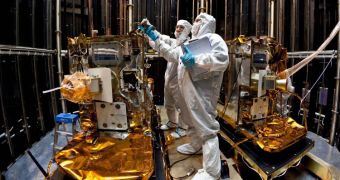Engineers at the Denver, Colorado-based Lockheed Martin Space Systems say that the twin GRAIL spacecraft NASA contracted them to build have finished testing, and are now ready for shipment.
The two Gravity Recovery And Interior Laboratory (GRAIL) probes are headed for the Moon. They will be launched on September 8, 2011, from the Space Launch Complex 17B, at the Cape Canaveral Air Force Station (CCAFS), in Florida.
A Delta II delivery system will carry both spacecraft, and set them on a path that will ensure their orbital insertion around Earth's natural satellite in January 2012. The GRAIL components are already finished, and have also completed all testing phases at Lockheed.
The latest tests, which lasted for 11 days, saw GRAIL-A and GRAIL-B subjected to simulations that tested many of the systems which will be used during the actual flight to the Moon, and during their stay there.
The twin, 200-kilogram (440- pound) probes successfully completed these trials on April 29. This is when the image attached to this article was taken. It shows GRAIL-A being hooked up for removal from the test chamber.
According to NASA, the main goal of the mission is to measure the Moon's gravity field in unprecedented detail, approaching the resolution of the European Space Agency's (ESA) GOCE satellite in Earth's orbit.
GRAIL “will create the most accurate gravitational map of the Moon to date, improving our knowledge of near-side gravity by 100 times and of far-side gravity by 1000 times,” NASA says on its website.
“The high-resolution gravitational field, especially when combined with a comparable-resolution topographical field, will enable scientists to deduce the Moon's interior structure and composition, and to gain insights into its thermal evolution,” the agency further explains.
This will allow investigators to paint a better picture of the cooling and heating spells the satellite passed through over the eons. In turn, this may lead to clarifying the Moon's origin, and to validating the theory saying that it was produced when a Mars-size planet impacted Earth.
“Accurate knowledge of the gravity will also be an invaluable navigational aid to future lunar spacecraft. Ultimately, the information contributed by the GRAIL mission will increase our knowledge of how Earth and its rocky neighbors in the inner solar system developed into the diverse worlds we see today,” the NASA statement concludes.

 14 DAY TRIAL //
14 DAY TRIAL //